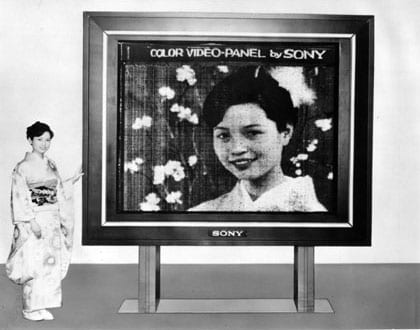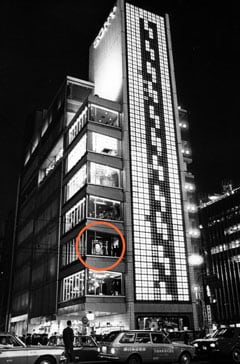Vol.13 : Being Ahead of the Times Has Limitations as well
Sony's Big-screen TV 40 Years ago
We are now in the age of big-screen TV. Out of all the consumer electronics products available today, the TV is probably the only one that has pleased people by getting larger, and amidst fierce competition among manufacturers, Sony is striking back with its BRAVIA. But if we go back 40 years, we find that Sony had already announced a big-screen TV that anticipated those of today.
It was in 1968 when Sony revealed to the world the first Trinitron Color TV, a product which would inevitably become a major contributor to a shining future for the company. This year, in fact, marks the 40th anniversary since its initial launch. Yet despite the fact it was such a busy time, the insatiable appetite of Sony engineers for challenge led them to come up with one idea after another, including a big-screen TV that caused a sensation when it was first announced. The new TV was not only an astounding 100 inches, but it boasted a flat screen. It was called the Sony Color Video Panel.
 An astonishing 100 inches! The Sony Color Video Panel. We do
An astonishing 100 inches! The Sony Color Video Panel. We do not know why the model wore a kimono, but we can speculate that
perhaps Sony wanted to emphasize its identity as a Japanese
company.
Today, numerous manufacturers have announced TVs with screens that exceed 100 inches, but this was no less than 40 years ago. According to the announcement, "At 1.5 meters high, 2 meters wide, 25 centimeters deep and with a 100-inch screen, this is the world's largest television receiver. This flat-screen color TV uses a new method unlike anything the world has ever seen. The screen comprises 78,000 color light elements in 260 vertical columns and 300 horizontal lines. An 'electronic brain' manipulates the broadcast signal received by the antenna, switching the screen's individual color light elements on and off to realize color broadcast." In other words, it was a light emitting display that realized video images using something similar to 78,000 miniature light bulbs.
Today it's easy to laugh at the fact that it used the equivalent of miniature bulbs, but this was in the heyday of the cathode ray tube (CRT), and Sony was poised to launch the Trinitron. Yet in spite of this, Sony took what had to be a very bold step in launching a TV that did not use CRTs.
In fact, it used 700 integrated circuits and cost ¥10 million. That's why it was never commercialized, but the "Jumbotron" exhibited at the International Exposition, Tsukuba, Japan, 1985 (TSUKUBA EXPO '85) was a gigantic 2,000-inch screen that inherited the big-screen concept and gave people a taste of even greater surprise and excitement.
 Sony did not hesitate to put it on
Sony did not hesitate to put it on display at the Sony Building in Tokyo's
Ginza so that passersby could see it.

